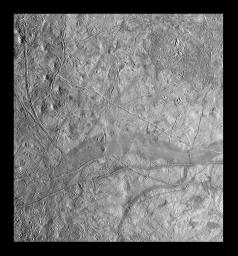This mosaic of part of Jupiter's moon, Europa, shows a region that is characterized by mottled (dark and splotchy) terrain. The images in this mosaic were obtained by Solid State Imaging (CCD) system on NASA's Galileo spacecraft during its eleventh orbit around Jupiter. North is to the top of the image, and the sun illuminates the scene from the right. Prior to obtaining these pictures, the age and origin of mottled terrain were not known. As seen here, the mottled appearance results from areas of the bright, icy crust that have been broken apart (known as "chaos" terrain), exposing a darker underlying material. This terrain is typified by the area in the upper right-hand part of the image. The mottled terrain represents some of the most recent geologic activity on Europa. Also shown in this image is a smooth, gray band (lower part of image) representing a zone where the Europan crust has been fractured, separated, and filled in with material derived from the interior. The chaos terrain and the gray band show that this satellite has been subjected to intense geological deformation.
The mosaic, centered at 2.9 degrees south latitude and 234.1 degrees west longitude, covers an area of 365 kilometers by 335 kilometers (225 miles by 210 miles). The smallest distinguishable features in the image are about 460 meters (1500 feet) across. These images were obtained on November 6, 1997, when the Galileo spacecraft was approximately 21,700 kilometers (13,237 miles) from Europa.
The Jet Propulsion Laboratory, Pasadena, CA manages the mission for NASA's Office of Space Science, Washington, DC. JPL is a division of California Institute of Technology.
This image and other images and data received from Galileo are posted on the World Wide Web, on the Galileo home page at URL http://galileo.jpl.nasa.gov. Background information and educational context can be found at http://www.jpl.nasa.gov/galileo/sepo.

 Planetary Data System
Planetary Data System












